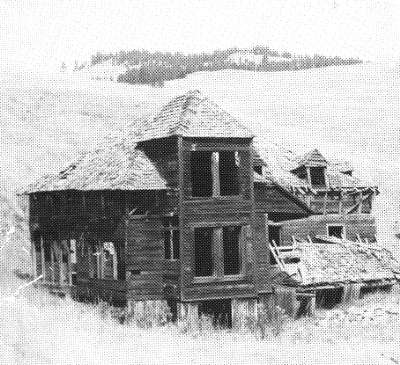
![]()
The first Wauconda came into being in 1898, after a wide ledge of quarts carrying free gold in it was discovered. This discovery touched off a headlong rush into the area as prospectors envisioned another Eureka Camp.
By 1898 a substantial community had grown up around the mine. Before long a general store, three crude hotels, four saloons, and a handful of other buisnesses catered to the miners needs. By 1901, a post office opened and Wauconda was on the map. The town soon claimed a population of 300.

By 1901, the mine was showing signs of depletion as the ore began depleting out. Soon after the mine closed down. Old Wauconda met its death. But the towns people simply picked up, and moved westward to a new site two miles away. The second Wauconda never matched the status of Old Wauconda. It had a school, post office, several places of buisness, and a growing population of homesteaders. A new highway between Republic and Tonasket was laid in 1929, which bypassed the second town of Wauconda. J.R. VanSlyke, picked up stakes in 1930, and moved his store and post office to a new site close to the new highway. Today the last Wauconda stands yet by highway 20, and not far from the original sites.
Wauconda today doesnít resemble that town of the past. But in every direction history beckons. To the north lies old abandoned ghost towns like Bodie, Old Toroda, and Sheridan. The hills and mountains are covered with abandoned mines. To the southwest the Indian country with its ancient Indian campsites, historic trails, and Indian pictographs. And close to Wauconda of today scores of abandoned log cabins and old deserted houses can be found. Donít miss seeing the old Pflug mansion south of Wauconda in a grassy draw close to the road.
From Dreams to Memories

John and Anna Pflug came to America in the fall of 1900 from Eastern Germany where they were born. John Pflug, was a small German man, and he had a dream of building a beautiful German style house for his growing family. He started building his dream home in the summer of 1908. Money was scarce in those early years for homesteaders, he hired no help, doing all the carpenter work himself and hauling the lumber from Turpenís sawmill on Bonaparte Creek, about ten miles away with a team and wagon. His German style home was never completed. Like most of the early homesteaders, he found that all he could do was to take care of his family and send there children to school.

John and Anna Pflug
The Pflug mansion has remained deserted since 1921, a reminder of the dreams our pioneer fathers before us once had.

On June 14, 1917, the Wauconda Community Hall was dedicated. Fifteen hundred people attended the big celebration. They came from all over Ferry and Okanogan counties.
More on Wauconda, Wauconda From Generation to Generation
![]()
